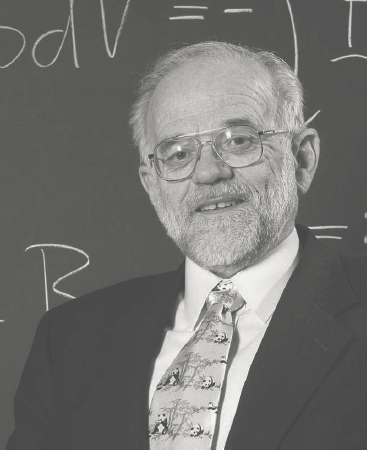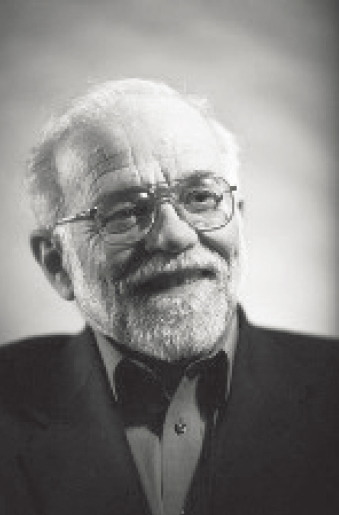

LANNY D. SCHMIDT
1938–2020
Elected in 1994
“For the application of principles of surface science to the design of new catalytic cycles and the molecular understanding of catalytic reaction engineering.”
BY RAYMOND J. GORTE, RAUL A. CARETTA, PAUL J. DAUENHAUER, AND ROBERT W. MCCABE
LANNY D. SCHMIDT, Regents Professor emeritus of chemical engineering and materials science (2002–14) at the University of Minnesota and lifelong student of chemical reacting systems, died March 27, 2020, at the age of 81.
He was born May 6, 1938, in Waukegan, Illinois, and, when the time came, enrolled at Wheaton College, where he received his bachelor of science degree in chemistry in 1960. He then proceeded to the University of Chicago, where he studied under the direction of Robert Gomer, one of the pioneers in ultra-high-vacuum (UHV) studies of adsorption on metal surfaces. Lanny’s thesis work involved studies of alkali metal adsorption on tungsten, utilizing field ion emission spectroscopy. After completing his doctorate in physical chemistry in 1964, followed by an additional year of postdoctoral work with Gomer, he accepted a faculty position at the University of Minnesota (lured by fellow Chicago grad H. Ted Davis), taking on the challenge of teaching chemical engineering and starting a research program focused on fundamental surface chemistry. Lanny remained on the Minnesota faculty for 49 years, and was designated emeritus in 2014.
The university’s Chemical Engineering Department provided a unique environment in the 1960s that transitioned from traditional unit operations to chemical engineering
theory and mathematical modeling. The department chair, Neal Amundson, assembled a faculty that included not only chemical engineers but mathematicians, biologists, and chemists. Lanny settled in quickly, initially continuing UHV studies of adsorption on single-crystal metals and then expanding to technologically important catalytic applications, including ammonia oxidation and automotive emissions control.
Studies of fundamental understanding of surface chemical mechanisms and kinetics ultimately formed the foundation of modern catalysis, evolving from global reaction kinetics to microkinetic models. Lanny capitalized on his surface chemistry experience, linking fundamental steps of reactant adsorption, surface reaction, and product desorption to develop detailed catalytic reaction models. His group published numerous studies of simple gas-phase reactions on metal surfaces, in many cases directly confirming Langmuir-Hinshelwood kinetics, but also revealing the rate-limiting steps as influenced by the choice of catalytic material and reaction conditions. This fundamental focus transitioned catalysis from a predominantly trial-and-error exploratory process to the molecular basis required to guide catalyst discovery and design.
Throughout his career, Lanny exhibited two overarching research characteristics that drove him to new, emerging problems. He continually pushed to evolve his research toward engineering technology, and he had an insatiable hunger for high-quality data as the driver of scientific discovery. He never lost his love of being in the laboratory and doing hands-on experiments. He was not beyond sneaking into the lab when his students were not around and doing experiments—sometimes pushing conditions to the extreme to satisfy his curiosity and desire for data.
While he started as a physical chemist and surface scientist, he transitioned in the 1970s to problems of particles and reacting flows, including early transmission electron microscopy studies of supported nanoparticle catalysts and novel flow-reactor designs. In particular, he developed new experimental techniques to understand catalytic reactions on surfaces at both vacuum conditions, where experimental insight was
obtained, and high-pressure conditions simulating real-world applications. He also invented techniques to understand fundamental reactions on different facets and defects of particles, as exist in supported heterogeneous catalysts. He went even further to predict the faceting of nanoparticles based on their surface energy, expanding the bridge between fundamental surface characteristics and industrial catalyst synthesis.
Lanny moved further into the field of reaction engineering in the early 1980s in collaboration with his colleague Rutherford (“Gus”) Aris as they focused on problems of complex catalytic systems including catalytic combustion. In a field dominated by modeling, Lanny introduced sophisticated experiments and intuitive insights into the chemistry to understand the interactions of coupled surface and gas-phase reactions. These experiments led to new understanding of the stability of catalytic reactors and the emergence of complex oscillatory surface chemistry and multiple steady states.
While those studies retained fundamental aspects, Lanny never lost sight of the potential applications. Initially, his forays into practical catalysis involved primarily reactions on unsupported metals, evolving from single crystals to wires and foils, and ultimately to simulations of noble metal mesh catalysts of the types used in the Ostwald process for nitric oxide production and the Andrussow process for HCN synthesis.
In 1989 Lanny solidified his break from surface science studies on unsupported metals to metals deposited on ceramic foam monoliths. He initially asked whether the platinum-rhodium (Pt-Rh) gauze that is used commercially in the Ostwald and Andrussow processes could be replaced with Pt on a cordierite monolith. This began his foray into short-contact-time reactors. Focusing critically on the methane-oxygen side of the Andrussow reaction composition space, he and his students successfully demonstrated high selectivity for methane oxidation to synthesis gas, a development that became the cornerstone on which Lanny built a successful multidecade short-contact-time research program.
The catalytic foam reactors opened the door to a wide range of millisecond-contact-time reactions. By operating
oxidative reactions on catalytic foams, Lanny invented reforming technology that could shrink conventional industrial reactor technology by orders of magnitude for basic chemical production. His breakthrough of methane autothermal reforming demonstrated small-scale capability for natural gas reforming. Following thereafter was a fast ethane dehydrogenation technology to mass produce ethylene in fast-responding microreactors. By developing novel experimental chemical sampling techniques, he was able to deconstruct both the fundamental surface catalysis and reaction sequence leading to fast selective chemistry, thereby pushing his students to advance both science and technology in parallel.
Lanny’s focus on novel reactor design ultimately led him to address catalytic technology for sustainability. In 2004 he invented a microreactor that could convert ethanol into hydrogen gas for the hydrogen economy. This breakthrough led to a decade of new technologies to utilize agricultural and lignocellulosic feedstocks to produce renewable fuels and chemicals and develop rural economies. His interest in chemical research expanded into the challenges of implementing a bioeconomy, and he advocated for research that integrated agriculture, chemical technology, energy, and the environment.
His passion for developing a new bioeconomy diffused into his teaching, where he integrated sustainability in his courses in reaction engineering and process design. Building on his leading undergraduate reaction engineering textbook, The Engineering of Chemical Reactions (Oxford University Press, 1997; the 2nd edition is still in print), he excelled at exciting engineering students to develop the sustainable chemical technology necessary to solve the problems of the next century. His lecture style was engaging, with a combination of deep knowledge of chemical reaction engineering and his inclination to include compelling and often entertaining anecdotes.
Lanny published over 350 papers with his students and collaborators, but his success as an educator and leader in chemical engineering also included his ability to develop researchers. He supervised students through more than 90 doctoral theses and 15 master’s theses; these students have gone on to successful
careers in both industry and academia, including four former students inducted into the NAE. Even more, Lanny’s style of curious and adventurous pursuit of research transferred to his students, creating an extended family of professional engineers—proudly referring to themselves as Schmidtsters—with a similar drive to measure, create, and invent bold new experiments and audacious chemical technologies.
As important as research and data were to Lanny, he also cared deeply about the well-being of his students—both in and beyond the lab. While he might have broken a student’s apparatus going for an extreme data point, he was right there to fix it, with dexterity and trouble-shooting skills that few could match.
Lanny’s contributions were recognized with various honors. In 1987 he received the Giuseppe Parravano Memorial Award for Excellence in Catalysis Research and Development from the Michigan Chapter of the North American Catalysis Society; it is presented to a researcher in North America “for outstanding achievement in the conduct of clever, productive, and influential research on problems of central interest and importance in catalysis and related fields.” In 1994 he was elected to the NAE and selected for the Humboldt Prize. In 2013 his innovative approaches to research were recognized with the Neal R. Amundson Award, presented to “a pioneer in the field of chemical reaction engineering who has exerted a major influence on the theory or practice of the field through originality, creativity, and novelty of concept or application.” And in 2014 he was named by Scientific American as one of the 50 most outstanding American scientists.
He and his wife, Charlotte (called Sherry), often invited students to their home where, among other things, they were introduced to the Schmidt menagerie of animals ranging from hamsters to a lineage of large dogs. To this day, Schmidtsters identify with the resident canine that marked their tenure in Lanny’s group, be it Anka, Gitta, Tasha, or Duke.
Though diminutive in stature, Lanny Schmidt was big of heart, and made unparalleled contributions—both fundamental and practical—connecting the fields of surface science, catalysis, and chemical reaction engineering.
He is survived by his wife of 58 years, Sherry (née Hargrave), daughters Diana Joy (Christopher Lee) Kitzman and Amanda Jean (Peter Hans) Docter, four grandchildren, and a legion of Schmidtsters.








